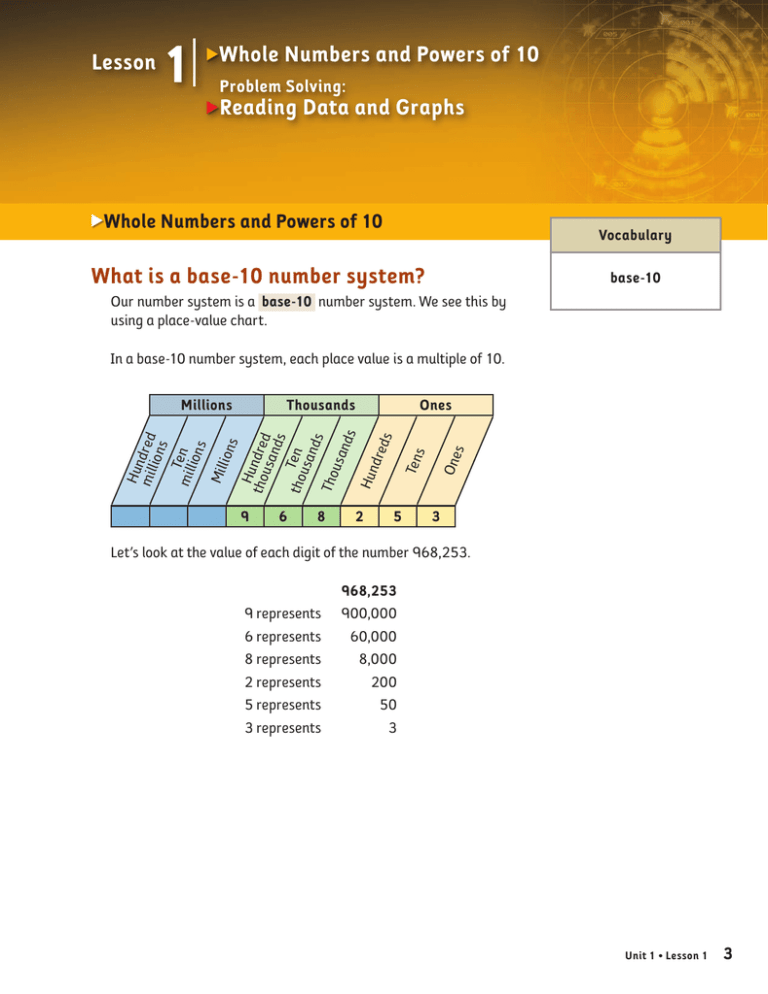
Lesson
1
Whole Numbers and Powers of 10
Problem Solving:
Reading Data and Graphs
Whole Numbers and Powers of 10
Vocabulary
What is a base-10 number system?
base-10
Our number system is a base-10 number system. We see this by
using a place-value chart.
In a base-10 number system, each place value is a multiple of 10.
9
6
8
2
5
One
s
Ones
Ten
s
Thousands
Hu
millndred
ions
T
mill en
ions
Mill
ions
H
thoundred
u sa
nds
T
tho en
u sa
nds
Tho
u sa
nds
Hun
dre
ds
Millions
3
Let’s look at the value of each digit of the number 968,253.
9 represents
6 represents
8 represents
2 represents
5 represents
3 represents
968,253
900,000
60,000
8,000
200
50
3
Unit 1 • Lesson 1 3
Lesson 1
How do we break down numbers to powers
of 10?
A systematic way to break down a number to a power of 10 is to break
it down to 10s, 100s, and 1,000s. Example 1 shows how to rewrite
numbers that are in the thousands using a power of 10. This means if
you divide the number by 10, there is no remainder.
Example 1
Rewrite the numbers using a power of 10.
1,000
7,000
9,000
· 10
100 · 10
700 · 10
900 · 10
· 100
10 · 100
70 · 100
90 · 100
· 1,000
1 · 1,000
7 · 1,000
9 · 1,000
Each number can be divided by a power of 10 with no remainder.
Understanding the place-value system will help when regrouping.
Example 2 shows how 10 ones are regrouped to make one 10 using
place-value coins. We also see 10 tens regrouped to make one 100.
This process goes on forever.
Example 2
Use place-value coins to show regrouping.
Hundreds
Tens
10
1
1
1
1
1
1
1
1
1
1
Ten 1s regrouped into one 10
4 Hundreds
Ones
Tens
10
10
10
10
10
1
10
10
10
10
10
1
10
10
10
10
10
100
Ten 10s regrouped into one 100
Apply Skills
Reinforce Understanding
Turn to Interactive Text,
page 2.
Use the mBook Study Guide
to review lesson concepts.
Unit 1 • Lesson 1
Ones
Lesson 1
Problem Solving: Reading Data and Graphs
Vocabulary
How do we use bar graphs to display data?
bar graph
trend
We use bar graphs to display data. Bar graphs show data
using colored blocks, or bars, and are an effective way to show
relationships and trends over time. Remember that trends are
patterns we see in a graph.
The following bar graph shows changes in the number of people who
have subscribed to a newspaper. The graph shows two things:
• The number of subscribers in each year.
• Trends over time.
Decline in Newspaper Subscribers
160,000
Number of Subscribers
155,000
150,000
145,000
140,000
135,000
130,000
125,000
120,000
1995
1996
1997
1998
1999
Years
2000
2001
2002
We can compare different years to see if one year has more subscribers
than another year. We can see the trend over time. In this graph, the
number of newspaper subscribers is going down.
Problem-Solving Activity
Reinforce Understanding
Turn to Interactive Text,
page 3.
Use the mBook Study Guide
to review lesson concepts.
Unit 1 • Lesson 1 5
Lesson 1
Homework
Activity 1
Tell the value of the underlined digit in each number.
1. 604,250
2. 13,871
3. 2,098,473
4. 107
5. 55,341
6. 4,300,001
Activity 2
Fill in the missing numbers in the table.
Starting Number
6,000
8,000
· 10
600 · 10
· 100
60 · 100
· 1,000
6 · 1,000
(a)
(b)
(c)
(d)
(e)
(f)
4 · 1,000
(g)
(h)
30 · 100
(i)
(j)
700 · 10
(k)
(l)
9,000
(m)
(n)
(o)
Activity 3 • Distributed Practice
Solve.
1.
367
+ 209
576
6 Unit 1 • Lesson 1
221
2.
478
229
249
3.
76
4
304
4.
87
9
5.
3q663
783
Copyright 2010 by Cambium Learning Sopris West®. All rights reserved. Permission is granted to reproduce this page for student use.

